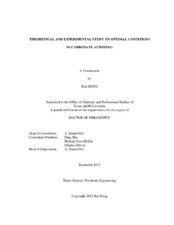| dc.description.abstract | Optimal acid injection rate is important to know for a carbonate matrix acidizing design. This rate is currently obtained through fitting acidizing coreflood experimental results. A model is needed to predict optimal acid injection rates for various reservoir conditions.
A wormhole forms when larger pores grow in cross-sectional area at a rate that greatly exceeds the growth rate of smaller pores due to surface reaction. This happens when the pore growth follows a particular mechanism, which is discussed in this study. Our model focuses on the growth of the pore with the mode size in a pore size distribution - the pore size that appears most frequently in the distribution. By controlling the acid velocity inside of it, we can make this particular pore grow much faster than other smaller pores, thus reaching the most favorable condition for wormholing. This also results in a balance between overall acid/rock reaction and acid flow. With the introduction of a porous medium model, the acid velocity in the mode-size pore is upscaled to the interstitial velocity at the wormhole tip. This interstitial velocity at the wormhole tip controls the wormhole propagation. The optimal acid injection rate is then calculated based on a semi-empirical flow correlation.
The optimal injection rate depends on the rock lithology, acid concentration, temperature, and rock pore size distribution. All of these factors are accounted for in this model. It can predict the optimal rates of acidizing coreflood experiments correctly for a variety of rock types, as compared with our acidizing coreflood experimental results. In addition, based on our model, it is also found that at optimal conditions, the wormhole propagation velocity is linearly proportional to the acid diffusion coefficient for a diffusion limited reaction. This is proven both experimentally and theoretically in this study. Since there is no flow geometry constraint while developing this model, it can be applied to field scales. Applications are illustrated in this study.
Due to fundamental differences of flow geometries, upscaling the linear flow acidizing coreflood experimental results to field scale has limited success. In this work, the optimal conditions for field scale are calculated directly from the optimal interstitial velocity at the wormhole tip. This eliminates the need for core scale optimal conditions. A simulated case with published field data is studied. Acid pumping rate is optimized for this case. Since the model inputs can be readily obtained from drill cutting analysis, the need for downhole cores is eliminated, making this model more practical.
Acidizing coreflood experiments with dolomite cores at varying temperatures are carried out. The rock porosity, permeability and pore size distribution are measured. The dissolution patterns are found by CT scan the acidized cores. Together with the model developed in this work, a treatment design method is developed for acidizing dolomite formations. Besides, suggestions are also made for the treatment. | en |


